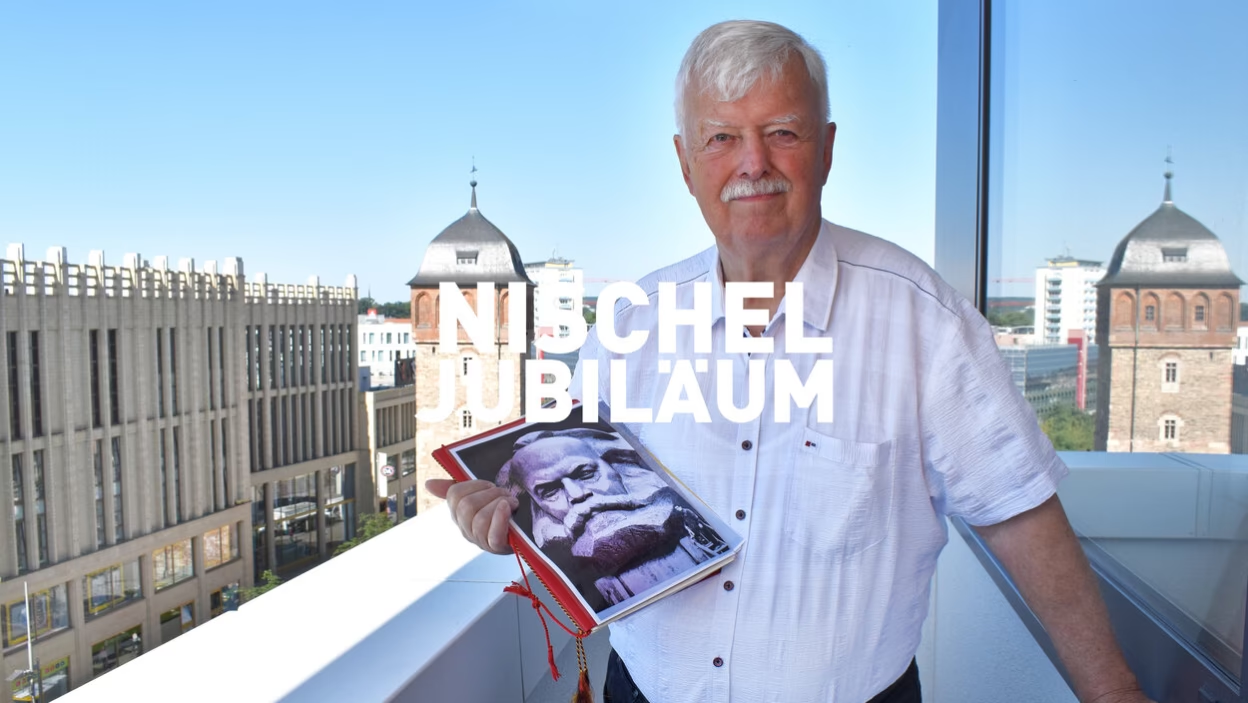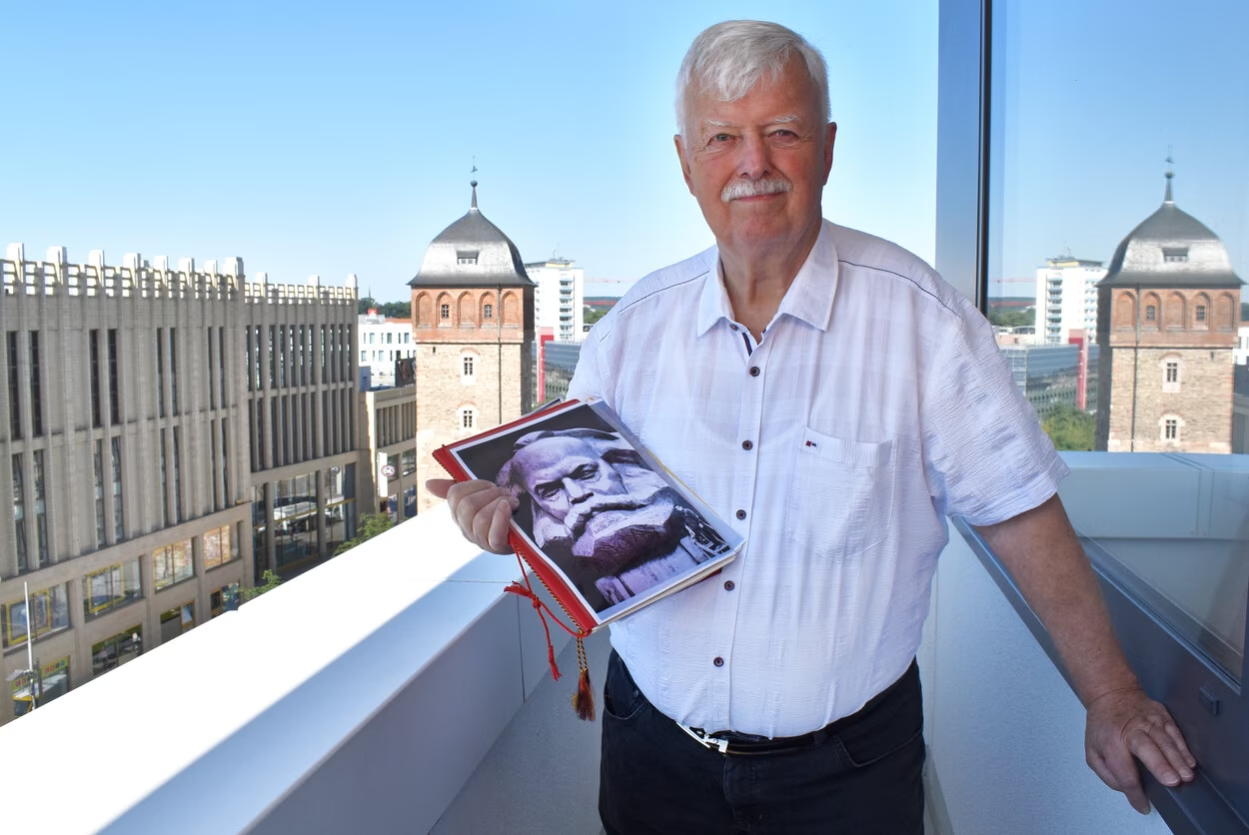Nischel anniversary: companions remember
A thousand metres of welding rod
Klaus Rüdiger

Karl-Marx-Stadt 1963 - Clear traces of the Second World War characterise the city centre: rubble, broken buildings and lots of space define the centre. The town hall and the Interhotel have not yet been built. It is the year in which Klaus Rüdiger moves to Karl-Marx-Stadt to take on a particularly difficult task with the construction of the Karl Marx Monument.
The young man came to Saxony from the Mansfeld copper slate mining industry and took up his position as site manager and construction preparer at the "Wilhelm Pieck" housing construction combine. "Back then, construction preparations were important to ensure that the materials needed for the construction were actually there at the right time. All the trades - bricklayers, plasterers, finishing trades, sanitary installations - had to be planned. Everything had to be done in sequence. And it was our job to determine this sequence," says Klaus Rüdiger in an interview with the Amtsblatt editorial team.
At that time, in 1963, the House of the Party, or "Party Fold", was in preparation, in which Rüdiger was directly involved. "Rudolf Weiser was the chief architect at the time. He designed a lot of things. Nobody wants to know today, but the party saw is Weiser's 'W' and a line. That's exactly how he signed it. He immortalised himself here."
Moscow adventure
The VE Wohnungsbaukombinat "Wilhelm Pieck" Karl-Marx-Stadt was to build the foundations and exterior of the Karl Marx Head. Rüdiger and his colleagues were responsible for preparing the "Fritz Heckert" construction area.
He got to know the city architects and employees and one day he was asked: "Tell me, are you going to Moscow? Do you fancy it?" Without even thinking for a minute, Rüdiger replied: "Of course I'm going to Moscow! What am I supposed to do there?" - "Well, the Karl Marx monument is being made there. Professor Kerbel is just about to finish it and we have to inspect it. As a construction expert, you're supposed to say whether it's possible." Rüdiger flew with him. Two hours with Interflug to Moscow. He was personally welcomed by Lev Kerbel at the Hotel Rossiya. Rüdiger recounts: "Then we met with Professor Kerbel in his studio, where the Karl Marx monument was created. It wasn't the monument that stands here, but the scale model. I no longer know how many tonnes of plaster were used. That was when the model was to be accepted by the city. Siegfried Arlt, the Head of Culture, Mr Schuster, the Head of the Fine Arts Office, and I were there. The three of us said: "Yes, that's how it should look."
Leningrad follows Moscow
Shortly after his visit to Moscow, Rüdiger had to travel to Leningrad again. The monument was cast there. He saw the monument for the first time on 18 August 1971. Cast and assembled in Leningrad. The individual elements were bolted together, which resulted in clearly visible joints. Rüdiger:
"That means we had three or four consultations with the engineers from Monument Skulptura and asked how we should close the joints. The answer was: 'Pour liquid bronze', 'Then what are we going to do down here in the beard, it's going to run out'. We certainly can't turn the head with 40 tonnes. 'You'll have to cast it.' A vertical joint like that wouldn't have filled up, it wouldn't have worked. Of course, we were very shocked at first." The only solution Rüdiger had in mind was to weld the 95 bronze parts together.
Thanks to the construction of the Interhotel Kongreß in Karl-Marx-Stadt, Rüdiger had good contacts at the Central Institute for Welding Technology (ZIS) in Halle. "We were now the ones who had to solve it, although I didn't actually have any knowledge about it. I'm neither a welding engineer nor an expert in this field. But I knew that the welding institute was an excellent company," recalls Rüdiger. "A good angel told me: 'Why don't you take two pieces of bronze like this with you, they'll make something out of it at the ZIS.' I packed two pieces of bronze in my briefcase."
The solution to the problem
Rüdiger was in Halle on 24 August 1971. They had 15 days to solve the problem. "It took the welding engineers at ZIS two hours to weld the two pieces of bronze together. They knew exactly which electrodes were needed. We asked our colleagues in Halle: 'Do you have enough electrodes?' 'Well, how much do you want to weld?' 'Well, about 1000 metres.' 'For God's sake, we'll have to order something new." Then the process began."
The people in charge in Karl-Marx-Stadt placed the order for the electrodes and decided which company should weld the head together. It was Germania. "That's our flagship company when it comes to welding," says Rüdiger. Everything else was organised, including the assembly. The Karl Marx head had to be dismantled in Leningrad and reassembled in Karl-Marx-Stadt. Kraftverkehr Karl-Marx-Stadt, Mittweida branch, organised the transport.
Rüdiger laughs: "I only know that the drivers said: 'We were on the road for eight days and brought the head here - four days there, four days back.' They told us a lot about what happened on the way."
The niche stands
When the Karl Marx head is finally in place, everyone is happy. Rüdiger remembers a photo in which Lew Kerbel can be seen alongside him and his colleagues. "That was the end of the 'Karl Marx Head' story and we are still happy today that it is there." After the monument was inaugurated, he received a handwritten dedication from Lew Kerbel.
The mayor at the time, Kurt Müller, presented Klaus Rüdiger with a medal and a certificate in honour of the construction of the city centre. "The nice thing about it was that workers, engineers and foremen were also honoured and not just the boss."


